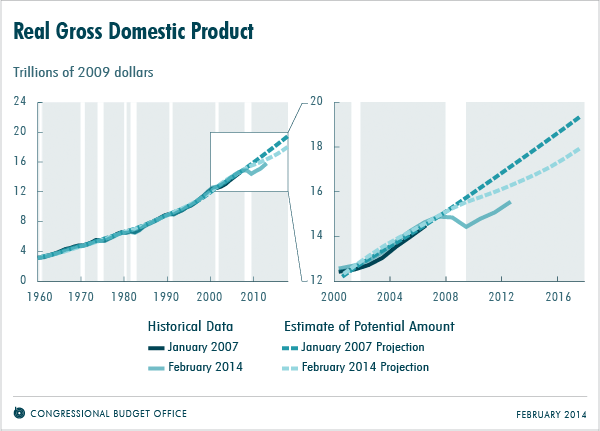Potential output is a useful thing to know. But, of course, it can’t be known … only estimated (we don’t go in to how you might do this in this class).
Not everyone produces a potential output number, but the Congressional Budget Office (CBO) does.

And, they’ve revised growth in potential output downward. What this reflects is their considered opinion that part (perhaps most) of what the U.S. economy has experienced over the last 7 years is permanent rather than transitory.
Perhaps surprisingly though, about 65% of the reduction is actually an adjustment reflecting overestimates of growth trends in earlier forecasts. Basically, they assumed that weakness they’d been seeing in growth rates for factors of production for a few years before 2007 weren’t temporary blips at all.
And, about 40% of their downward revision is attributable to one factor: declining participation in the labor force. I’ve argued before that we’re in a descent for that variable that predates the Great Recession (heck: it even predates the recession before the last one), and which we expect to continue for another 10 years or so.
============================================
It’s useful to think a little bit about how dynamics (of any process) have to work.
If potential output is the target, it’s a moving target. As you approach a target, you need to slow down. This also implies that you’ll go faster when you’re further away. This means that your path as you approach the target is curved: heading right towards it when you’re far away, and drawing parallel when you’re close.
DIGRESSION: note that I’m just going through the math. I’m not sure the economy has a target at all. If it doesn’t, then this is all moot. But if it does, then we need to think about how the math will work.
Part of our understanding of recovery in the wake of the Great Recession is conditioned by this. If potential GDP is a target that the economy approaches, and if it’s stationary, then we should have grown faster right after the trough. You know … approach fast, and then slow down when you get close. And if we had a big recessionary gap, we should’ve grown really fast.
But, we didn’t. This is part of the basis that a lot of people have for thinking the economy isn’t recovering well: it should be getting back to the target more quickly than it is.
Unless the target got closer to us. If the target got closer, we’d need to slow down earlier.
When you look at the panel on the right above, you don’t see that curvature of approach to the darker dashed line. Now, it’s really easy to say there’s something wrong with the economy when you see that. But what most people fail to recognize is that it also means something is goofy about the math. Think about that: a lot of people say the economy is all Obama’s fault, but no one is saying “And, oh yeah, Obama’s so omnipotent that he can also goof up the mathematics of approach to a moving target.” They don’t say that because it’s ridiculous. But, perhaps that means the whole “It’s Obama’s fault” position is ridiculous.
ANOTHER DIGRESSION: I’m not saying it isn’t Obama’s fault. What I’m saying is that there’s a set of 3 ideas that go together: 1) the economy’s approaching a moving target, 2) Obama is holding us back, and 3) he’s not only screwing up the economy but he can change how the math works too. It’s that combination of 3 things that’s ridiculous. But if one of them is wrong, then we’re OK (even if we don’t have a firm answer yet).
Now look again at the lighter dashed line in the panel on the right. The perspective is upside down, but relative to that dashed line, the economy is on an approach path consistent with the math. So, in some sense, the revision to potential GDP makes the experience of the last 5 years more consistent with how the math needs to work.
And this changes the question we need to ask as macroeconomists. It’s not how and to what extent recent policies have affected current GDP and growth, it’s why recent policies have caused potential output to change. That’s not the biggest component in the table in the source article, but it’s still the second biggest one. Plus, perhaps there are some policies that have reduced the second column too, above and beyond the demographics.
No comments:
Post a Comment